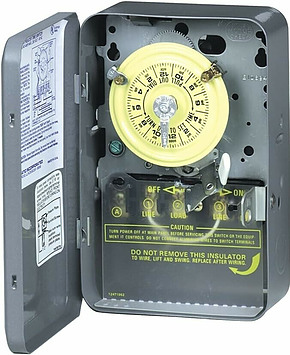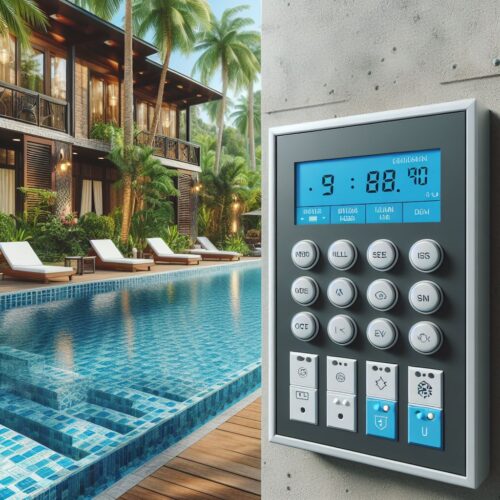
If you own a pool, you’re familiar with the maintenance that comes alongside the leisure it provides. Regularly managing pumps, heaters, and filtration systems is essential, but doesn’t have to be a daily chore. That’s where pool timers come in – they’re the unsung heroes of pool care, offering both convenience and cost-savings.
A pool timer automates essential functions, cycling your pump and other systems only when needed. This smart management translates into lower energy bills and a reduced carbon footprint.
Whether you’re home or away, the pool timer ensures your pool’s health without unnecessary expenditure or manual intervention. Navigating the market for pool timers reveals a variety of options, each with its own set of features.
You’ll find simple mechanical timers that handle the basics, to advanced digital models with customizable settings and remote control capabilities. Your choice hinges on your pool’s specific requirements and your personal preferences.
In this introduction, I’m laying out the groundwork for making an informed decision and preparing you to set up the pool timer that will serve you best. In the right hands, a pool timer is more than just a gadget; it becomes a crucial tool in your pool maintenance toolkit.
Check Out Our Recommended Timers on Our Amazon Storefront!
Pre-Installation Checklist: Getting Ready
Before you can enjoy the ease a pool timer adds to your life, you need to tackle the installation. Feeling prepared can turn this task from daunting to doable, so here’s a rundown of what you’ll need to gather and look out for.
TOOLS AND MATERIALS: Make sure you have the essentials – a screwdriver, wire strippers, wire connectors, and the pool timer manual. Having everything within reach can save you time and stress.
SAFETY FIRST: Working with electrical components can be dangerous. Cut power to the pool equipment at the circuit breaker before you start. Better safe than sorry, always.
LOCATION, LOCATION, LOCATION: Choose a place for your pool timer that’s dry, within sight of the pool, and protected from the elements. Accessibility matters if adjustments are needed later on.
COMPATIBILITY CHECK: Confirm that the pool timer is suitable for your pool pump’s voltage requirements. This step is crucial to prevent damage to your equipment and to make your installation a success.
By checking these items off your list, you’re setting the stage for a smooth installation process. Remember, paying attention now can save you trouble later.
With your checklist complete and safety measures in place, you’re ready to move on to the main event – the actual installation. Up next, I’ll walk you through every detail of getting your pool timer up and running.
Step-by-Step Guide to Installing Your Pool Timer
You’ve got your tools ready, taken all safety measures, and chosen the perfect spot for your pool timer. Now it’s time to get down to the nitty-gritty of installation. I’ll walk you through the process, but remember, if you’re ever in doubt, don’t hesitate to call a professional.
- First, make sure the power to the pool equipment is completely OFF. Safety should always be your number one concern. Now you’re ready to mount the timer. Typically, pool timers come with a mounting bracket. Secure this to the wall with screws, ensuring it’s level.
- Next, it’s all about the wires. You’ll have a power supply line, and lines running out to your pump. Referring to your timer’s manual is crucial here, as wiring can vary between models. Generally, you’ll connect the live wires from the power supply to the timer’s ‘Line’ terminals and the pump wires to the ‘Load’ terminals.
- After you’ve connected the wires, set the current time on your timer. There’s usually a dial for this purpose. Align the current time with the timer’s mark that indicates ‘Now’.
- Programming your pool run time is your final setup step. Most timers have ‘On’ and ‘Off’ trippers. These should be inserted at the times you want your pump to start and stop operating. For example, if you want your pool to run from 8 AM to 8 PM, put the ‘On’ tripper at 8 AM and the ‘Off’ tripper at 8 PM.
- Once everything is in place, restore power to the pool system and watch to make sure the timer activates the pump as you’ve scheduled. If there’s any hiccup, turn the power off again and recheck your connections.
When you have confirmed the timer is functioning as expected, put the protective cover back on. This helps prevent any electrical hazards and protects the timer from weather elements. With your pool timer now correctly installed, you’ll start seeing the benefits of regulated run times on your energy bill and maintenance routine.
Total Pool & Hot Tub Course Bundle!Get all four pool and hot tub courses including The Pool Care Video Course, The Hot Tub Video Course, Money-Saving Guide for Pool Owners, and the Pool Winterization Course for one low price!
Maintaining Your Pool Timer: Tips and Best Practices
Your pool timer is the unseen conductor, keeping your pool’s systems in harmony without requiring constant attention. But even the best conductors need a little care to ensure they continue to perform well. Routine maintenance not only helps extend the life of your pool timer, it also makes sure it runs efficiently.
Start with a simple inspection every few months. Look for any signs of wear and tear or loose wires that could signal potential problems. Clean away any dirt or debris that might interfere with the timer’s operations; a soft brush or a can of compressed air usually does the trick.
As seasons change, it’s vital to adjust your timer accordingly. In the summer, your pool might need more filtration time due to frequent use, whereas in the winter, you can scale back to save on energy costs. Pay special attention to daylight savings adjustments to keep your schedule on track.
While it’s important to be proactive with your pool timer’s care, some issues might require a professional’s touch. If you notice your timer isn’t keeping accurate time or if it’s not responding correctly to your programmed settings, it may be time to call in an expert.
Don’t forget, that support and advice are at hand if you need it. Many manufacturers offer online resources or helplines that you can consult. Remember, keeping your pool timer in good working order is essential for ensuring your pool is ready for a swim whenever you are.
I am delighted by your active participation and interest in our recent article about pool timers. I am immensely grateful for your continued support and engagement in this community.
Thank you for being a part of our learning journey and contributing to the growing body of knowledge around pool care.
Your curiosity and passion for pool maintenance are what propel us to continue providing quality content. Stay tuned for more enlightening discussions and content as we dive deeper into the world of pool maintenance together.
Stay on Time!

